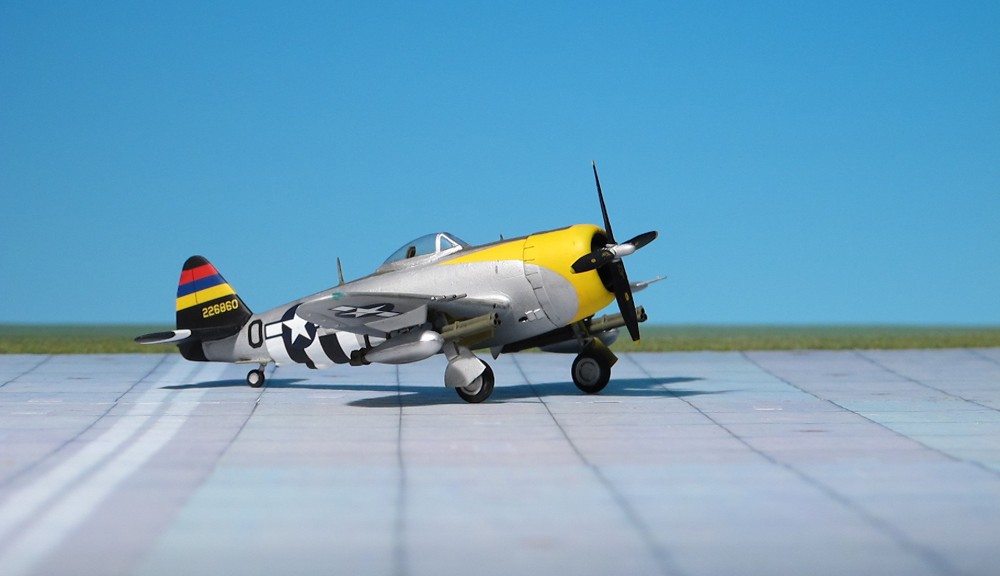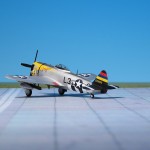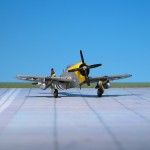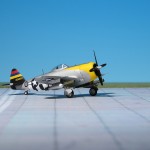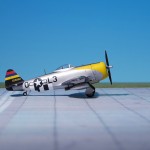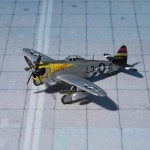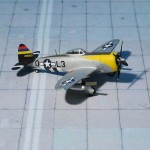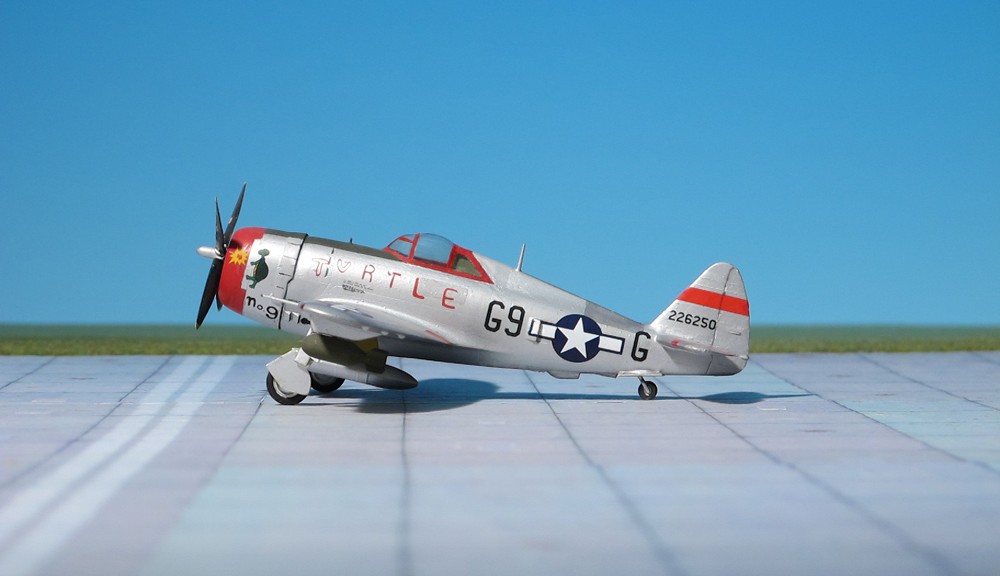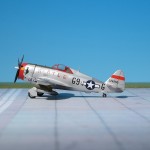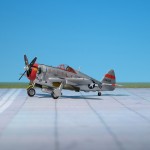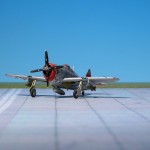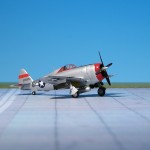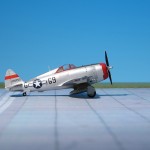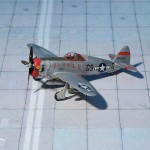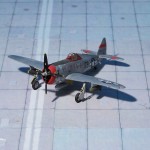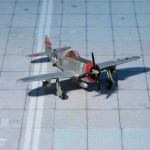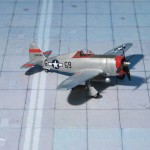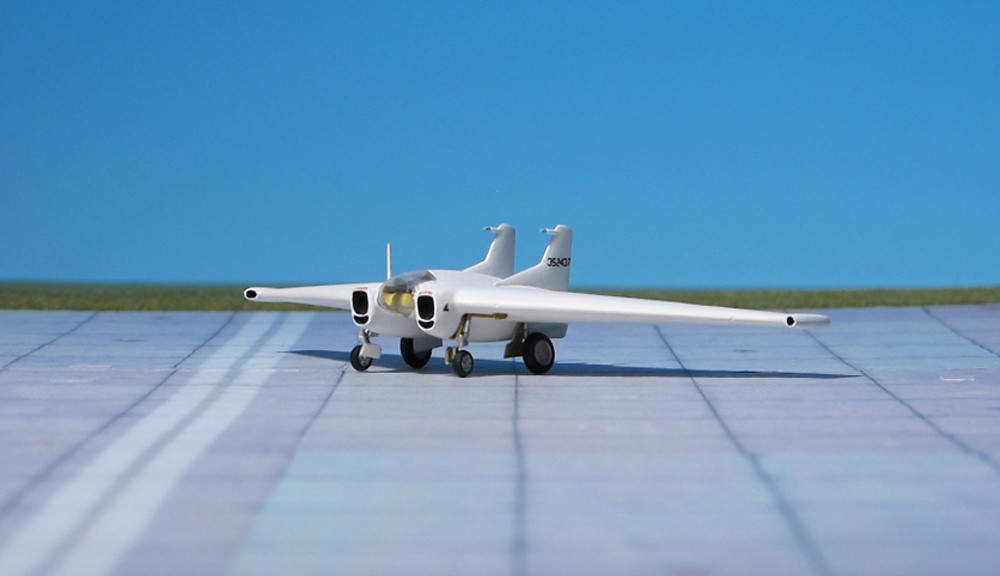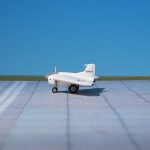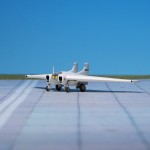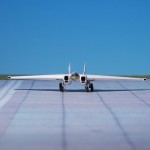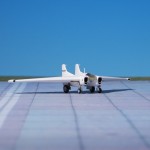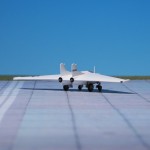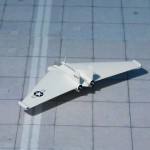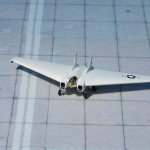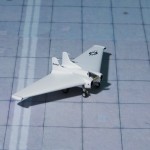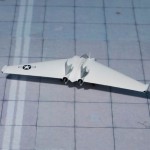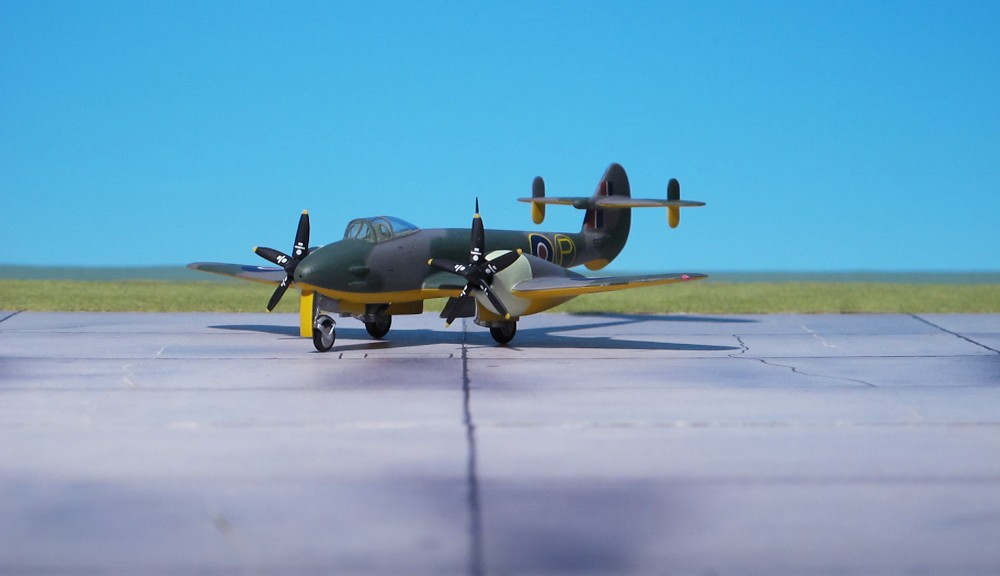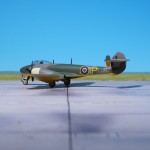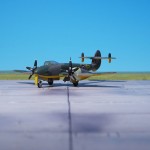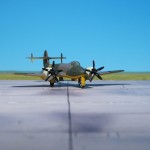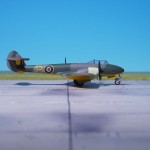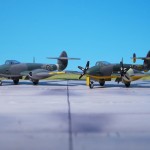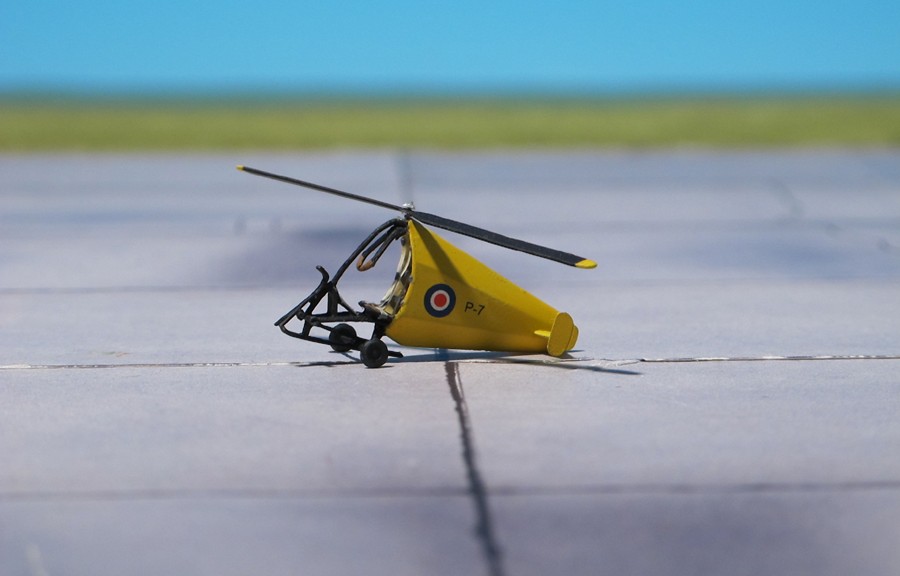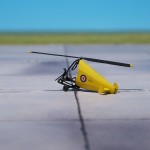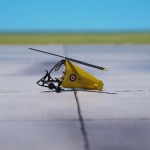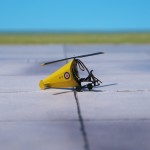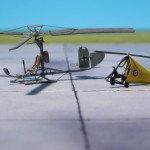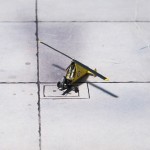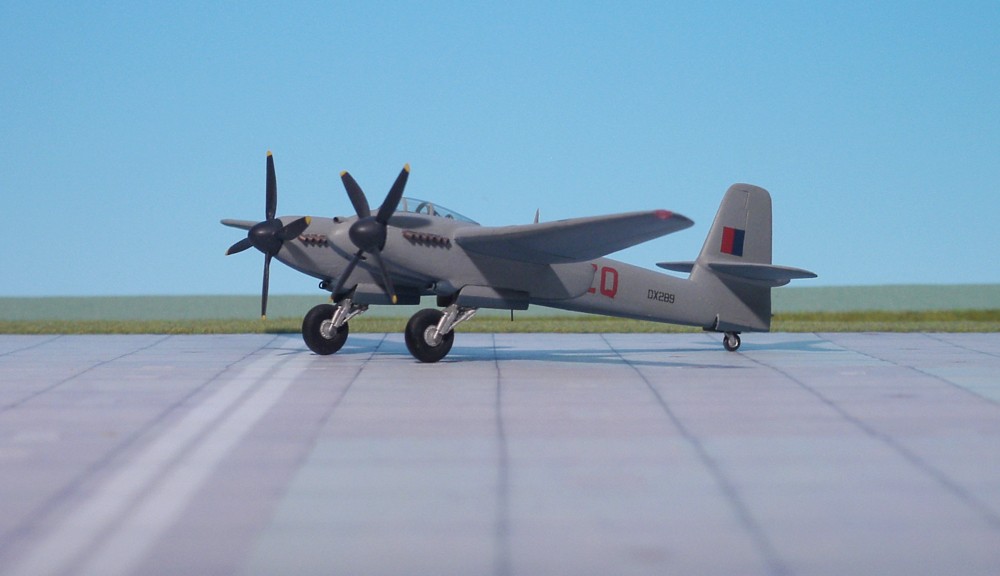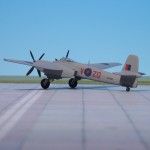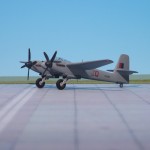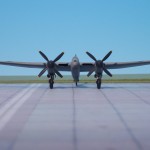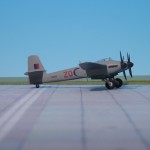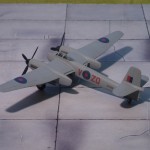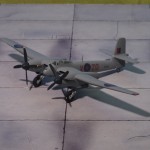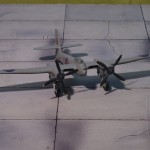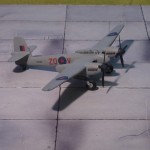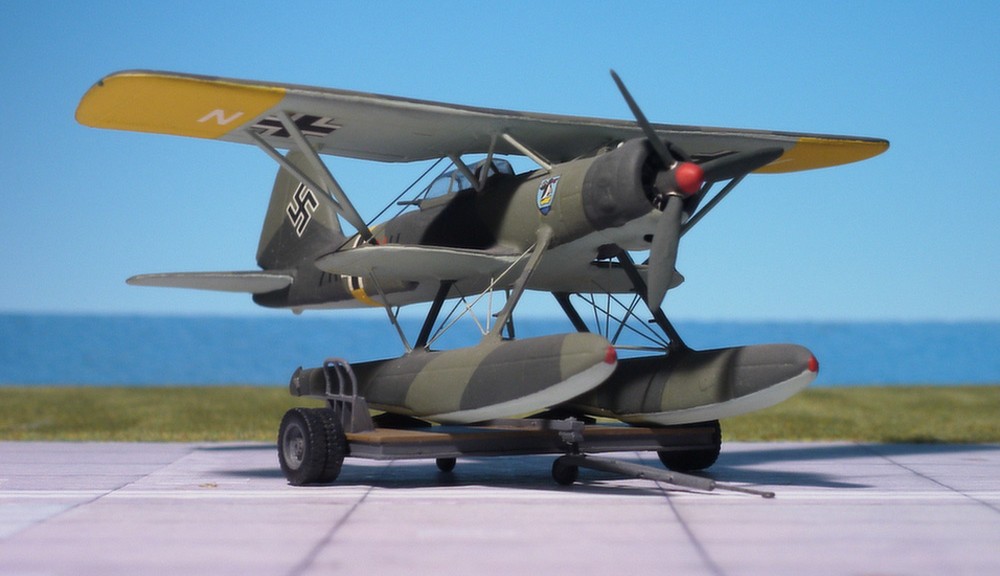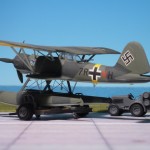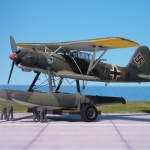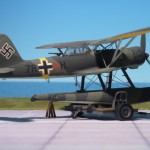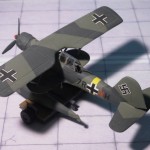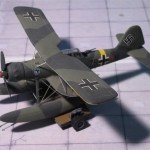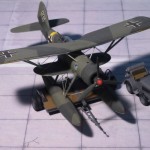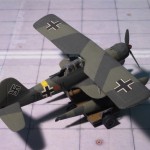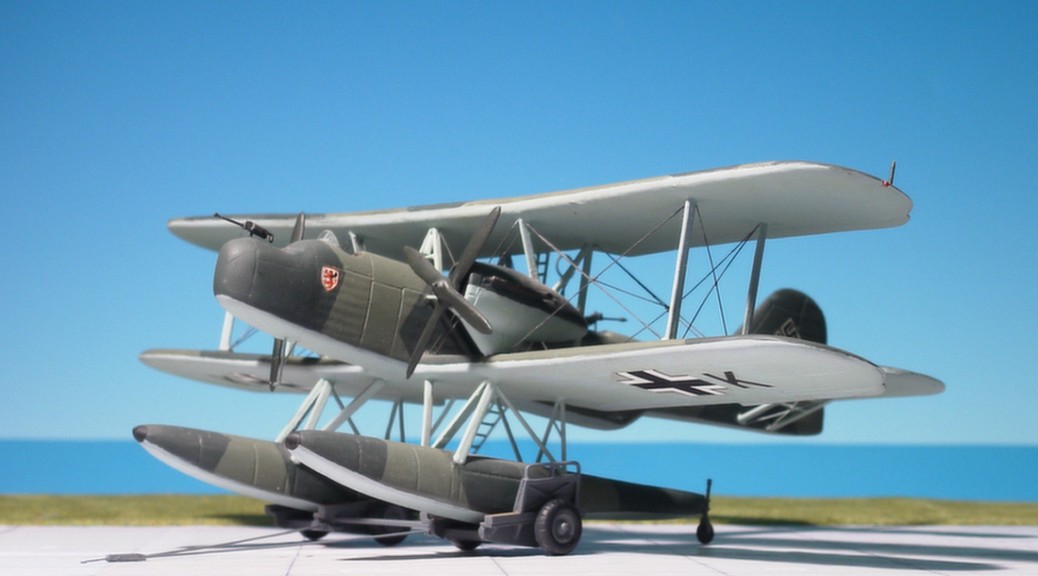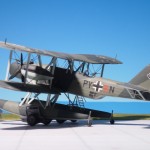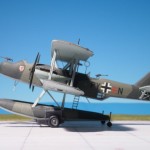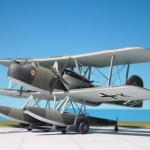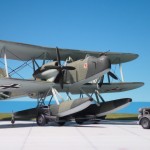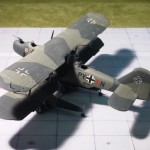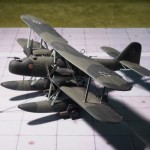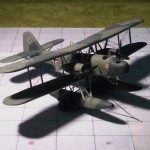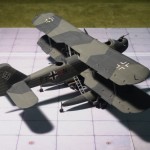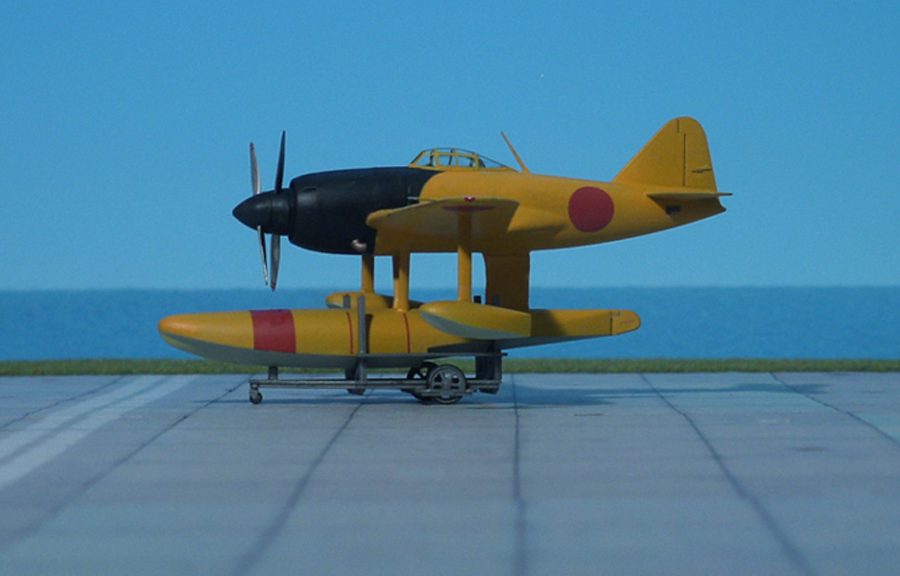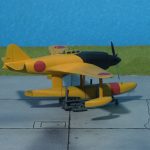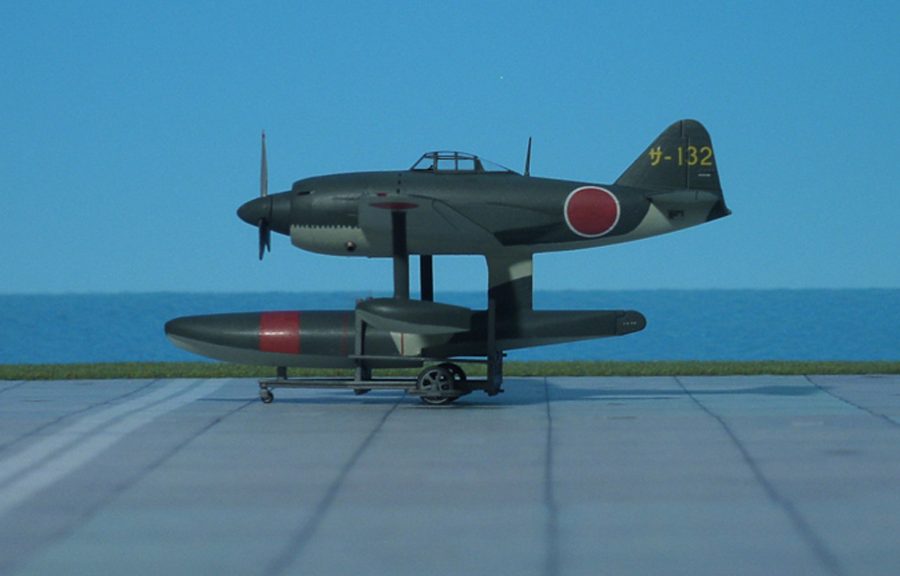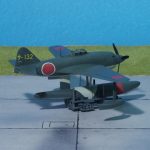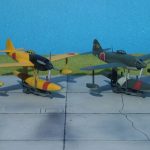All posts by Gunther Arnold
Republic P-47D-22-RE Thunderbolt, 509 FS, 405 FG (Revell, Parts from Pavlamodel)
Northrop XP-79B Flying Ram (RS Models)
TYPE: Interceptor fighter
ACCOMMODATION: Pilot only, in prone position
POWER PLANT: 2 x Westinghouse 19B (J30) jet engines, rated at 650 kp each
PERFORMANCE: 547 mph
COMMENTS: In 1942 John K. Northrop conceived the XP-79 as a high-speed rocket-powered flying-wing fighter aircraft. In January 1943, a contract for two prototypes with designation XP-79 was issued by the United States Army Air Forces. To test the radical design, glider prototypes were built, designated MX-324. Originally, it was planned to use a Aerojet XCALR-2000A-1 liquid-fueled rocket motor rated at 920 kp thrust supplied by monoethylanilin and red fuming nitric acid. Because of the corrosive and toxic nature of the liquids, the XP-79 was built using a welded magnesium alloy monocoque structure to protect the pilot if the aircraft was damaged in combat with a 3 mm skin thickness at the trailing edge and a 19 mm thickness at the leading edge. However, the rocket motor configuration using canted rockets to drive the turbopumps was unsatisfactory and the aircraft was subsequently fitted with two Westinghouse 19-B (J-30) turbojets instead. This led to changing the designation to XP-79B. The nickname “Flying Ram” is attributed to the unusual fighting tactic. It was planned to fly with high speed direct towards the enemy and to hit it with wingtips or fuselage. Due to its extreme stability the fighter and its pilot should survive. The XP-79B was lost during its first flight on 12 September 1945. Shortly thereafter, the second and the overall project was cancelled (Ref.: 23).
Gloster ‘Meteor’ F. I Trent Turboprop (MPM)
TYPE: Experimental testbed
ACCOMMODATION: Pilot only
POWER PLANT: Two Rolls-Royce RB.50 Trent turboprop engines, rated at 750 hp and 570 kp thrust each
PERFORMANCE:
COMMENT: Experimental works with early jets proved that in the speed range of less than 450 mph the substantial reduction of fuel consumption can be obtained by fitting a reduction gearbox to the impeller of a turbojet engine driving an airscrew. In German companies such as BMW, Heinkel and Junkers were pioneers related to this new power unit and some of these were in an advanced stage of realization (Messerschmitt Me 262B-2 “Turboprop”), but the end of the war stopped all further works. Also in the UK this idea was materialized by Rolls- Royce in the form of a ‘Trent’ turboprop engine what was in fact a modified ‘Derwent’ turbojet, fitted with shaft reduction gearbox and five-bladed Rotol propellers. Two ‘Trent’ turboprops were installed in a Gloster ‘Meteor’ F. 1 turbojet fighter as a test bed. The aircraft needed little modification for the accommodation of the ‘Trent’ power plant, though the nacelles were somewhat larger, which, with the extra side area of the propellers, entailed the fitting of two small auxiliary fins towards the outboard end of the tail plane to ensure directional stability. The Gloster ‘Trent’-Meteor and became the first aircraft to take-off and fly solely on turboprop power on September, 1945. By March 1948 the development program had been completed. The results of it were embodied in highly successful Rolls-Royce ‘Clyde’ and ‘Dart’ turboprop engines (Ref.: 24).
Hafner H.8 Rotachute Mk.IV (Fly)
TYPE: Autogyro
ACCOMMODATION: Pilot only
POWER PLANT: none
PERFORMANCE: 108 mph at tow
COMMENT: The Hafner H.8 Rotachute was a British 1940s experimental one-man rotor kite designed by Raoul Hafner, an Austrian engineer who specialized in rotary wing design, and who had moved to the UK in 1933 to continue his research and development work. In 1940, he proposed the use of a single-place strap-on rotor kite in place of a conventional parachute, to deliver a soldier accurately to a battlefield. The proposal was made to the Air Ministry in the light of a shortage of silk for parachute manufacture. Hafner was briefly interned as an alien, but was released to pursue the feasibility of the idea at the Central Landing Establishment (CLE) located at RAF Ringway. In October 1940, work began on design and construction of rotor systems and scale models of rotor kites. The first models were made of wood and fabric, ballasted to represent a pilot, and had a rotor span of about 3 ft. They were tested successfully by hand launching, but suffered buffeting and lack of autorotation when launched from aircraft at height. The third evolution, designated “M.3”, had metal rotor blades, and after further modifications made the first successful launch and descent from a De Havilland Tiger Moth. Further developments and tests continued into February 1941. The tenth evolution scale model (M.10) had mass-balanced wooden rotors, ballast of 45.3 kg, and a rotor span of 10 ft. On March 1941, the M.10 model was successfully air-launched from a Boulton & Paul Overstrand.
The design of the man-carrying machine known as a Rotachute, also known as a Hafner H.8, evolved from November 1940 and throughout 1941. In September 1941, the Central Landing Establishment was renamed the Airborne Forces Establishment. The Rotachute Mark I design initially comprised a tubular steel framework with a single seat, rubber-mounted rotor hub, hanging control column, skid undercarriage, and a self-inflating rear fairing made of rubberised fabric with integral tailplane. The two rotor blades, of wooden construction, could achieve flapping and coning characteristics via hinges on the rotor hub. Fixed footrests were provided, plus fittings below the seat to accommodate a soldier’s weapon, such as a Bren gun. The control column offered two-axis control, rolling and pitching, with turns made via controlled rolling movement. Air Ministry Specification No. 11/42 was issued retrospectively to describe the outline requirements. The Ministry of Aircraft Production sub-contracted construction of parts to specialist firms including F. Hills and Sons, Airwork General Trading, Dynaflex, Dunlop, and H. Morris & Co. Some full size rotor trials were carried out using a pivoting rig mounted on a Ford flatbed truck, and full-size unmanned airframes were used in ground-based and inflight trials.
In January 1942, trials of the Rotachute Mark I were conducted to assess the aerodynamic characteristics while mounted on the truck-mounted rig, with pilot control of the aircraft in forward motion. On 11 February 1942, the prototype Rotachute was first manually flown from a wheeled trolley while under tow behind a Humber car at Ringway, after starting the rotor by hand. On that and on a subsequent trial, the machine rolled over after landing, sustaining damage to the blades but not to the pilot. A tethered test beneath a barrage balloon and a longer test flight at RAF Snaith were both more successful. The flexible tail section evidently offered inadequate directional stability, and the consequence was the Rotachute Mark II, that had a longer tail section braced with wooden formers, plus two landing wheels mounted below the center of gravity.
On 15 February 1942, the unit was again reorganized, to form the Airborne Forces Experimental Establishment (AFEE), still based at Ringway. The rotary wing section of AFEE continued to conduct tests on longer runways during detachments at RAF Snaith and RAF Chelveston. On 29 May 1942, the first flight of the Rotachute Mark II was achieved while under tow behind a Jeep, and several more towed flights were also successful. Meanwhile, the Mark III had been produced, with a tail section comprising a wooden framework covered in doped linen fabric plus a rigid tail plane. Starting on 2 June 1942, the Rotachute Mark III was flown at heights up to 100 ft while under tow behind a Jeep, with tow rope lengths up to 300 ft. From 9 June, successful inflight releases and landings were achieved while under tow.
From 17 June 1942, a Rotachute Mark III was air-towed behind a Tiger Moth on a 300 ft tow line. After two towed flights, the Rotachute was released at an altitude of 200 ft and made the first manned free flight and controlled landing. Further free flights were made from altitudes up to 3,900 ft. On 1 July 1942, AFEE moved its main base from Ringway to RAF Sherburn-in-Elmet. Additional directional stability was achieved in the Rotachute Mark IV that introduced endplates onto the rigid tail planes.
Although the Rotachute concept had proved to be practical, the operational requirements for such a machine never materialised. About eight Rotachutes were constructed, most being progressively converted to Mark III and then to Mark IV specifications. They continued to be flown in ground-based and inflight trials until late 1943, to help research flight characteristics for a follow-on project, the Hafner Rotabuggy, an air-towed land vehicle (Jeep) with autogiro capabilities (Ref.. 24).
Westland Welkin Mk.I (Czechmaster, Resin)
TYPE: High-altitude Interceptor
ACCOMMODATION: Pilot only
POWER PLANT: Two Rolls-Royce Merlin 76/77 liquid-cooled engines, rated at 1,250 hp each
PERFORMANCE: 387 mph at 26,000 ft
COMMENT: The Westland Welkin was a British twin-engine heavy fighter from the Westland Aircraft Company, designed in 1940 to fight at extremely high altitudes, in the stratosphere. Westland had some expertise in twin-engine aircraft; its Whirlwind Mk.I escort fighter was in full production. The word Welkin means “the vault of heaven” or the upper atmosphere. As mentioned, first conceived in 1940, it was built from 1942–43 in response to the arrival of modified Junkers Ju 86P bombers flying reconnaissance missions that suggested the German Luftwaffe might attempt to re-open the bombing of England from high altitude. But the threat was never materialized. Consequently, Westland produced only a small number of Welkins. In total 77 aircraft were built but only few of these flew. Most of the aircraft were produced without engines. One sole aircraft was modified as Welkin II which had a lengthened nose to accommodate A.I. radar (Ref.: 23).
Heinkel He 114A-2 (Airmodel, Vacu)
TYPE: Reconnaissance floatplane
ACCOMMODATION: Pilot and observer
POWER PLANT: One BMW 132K radial engine, rated at 960 hp
PERFORMANCE: 208 mph
COMMENT: The Heinkel He 114 was a sesquiwing reconnaissance seaplane produced for the German Kriegsmarine (German Navy) in the 1930s for use from warships. It replaced the company’s Heinkel He 60, but did not remain in service long before being replaced in turn by the Arado Ar 196 as standard spotter aircraft.
While the fuselage and flotation gear of the He 114 were completely conventional, its wing arrangement was highly unusual. The upper set of wings was attached to the fuselage with a set of cabane struts, as in a parasol wing monoplane, whereas the lower set was of much lesser span while having approximately the same chord. This general layout is not especially unusual, and is known as a “Sesquiplane”, or a biplane which has a smaller lower wing. Typically, the lower wing is about 3/4 of the span of the upper wing, and has a smaller chord as well. The He 114 has a much shorter lower wing than usual, but has the same chord as the upper wing, which keeps the wing area ratio similar.
The He 114 was never a great success, was not built in large numbers, and served with the Luftwaffe for only a short time. While the Heinkel He 60 had handled very well on the water but been sluggish in the air, the He 114’s handling while afloat was poor and its performance in the air scarcely better than the aircraft it replaced (Ref.: 24).
Heinkel He 59D-1 (Airmodel, Vacu)
TYPE: Torpedo bomber, minelaying, reconnaissance, air-sea rescue aircraft
ACCOMMODATION: Crew of four
POWER PLANT: Two BMW VI 6.0 liquid-cooled engines, rated at 660 hp each
PERFORMANCE: 137 mph at sea level
COMMENT: The Heinkel He 59 was a German biplane designed in 1930 resulting from a requirement for a torpedo bomber and reconnaissance aircraft able to operate with equal facility on wheeled landing gear or twin-floats.
In 1930, the Heinkel Aircraft Company began developing an aircraft for the Reichsmarine, precursor of the Kriegsmarine. To conceal the true military intentions, the aircraft was officially a civil aircraft. The Heinkel He 59B landplane prototype was the first to fly, an event that took place in September 1931, but it was the He 59A floatplane prototype that paved the way for the He 59B initial production model, of which 142 were delivered in three variants. The Heinkel He 59 was a pleasant aircraft to fly; deficiencies noted were the weak engine, the limited range, the small load capability and insufficient armament.
The keels of the floats were used as fuel tanks – each one holding 900 l of fuel. Together with the internal fuel tank, the aircraft could hold a total of 2,700 l of fuel. Two fuel tanks could also be placed in the bomb bay, bringing the total fuel capacity up to 3,200 l. The propeller was fixed-pitch with four blades.
During the first months of WW II, the He 59 was used as a torpedo- and minelaying aircraft. Between 1940 and 1941 the aircraft was used as a reconnaissance aircraft and in 1941-42 as a transport, air-sea rescue, and training aircraft. In total 142 aircraft were built in various subtypes. The trainer and air-sea rescue version was designated Heinkel He 59D-1. The trainer models survived slightly longer in service than operational models, but all had been retired or destroyed by 1944 (Ref.: 24).
Kawanishi N1K1 “Kyofu” (“Mighty Wind”), 1st Prototype (Hasegawa)
TYPE: Float seaplane fighter
ACCOMMODATION: Pilot only
POWER PLANT: One Mitsubishi MK4D “Kasei 14” radial engine, rated at 1,460 hp, driving contra-rotating two-blade propellers
PERFORMANCE: 300 mph at 17,650 ft
COMMENT: Appearing too late to serve in its intended role, the Kawanishi N1K1 “Kyofu (“Mighty Wind”) floatplane fighter participated only briefly in combat operations but it sound design led to its adaptation into one of the most successful land-based fighter aircraft of WW II, the Kawanishi N1K1-J “Shiden”.
Development of a series of floatplane fighters intended to provide air support to Japanese amphibious landing forces in areas where no airfield existed was initiated in 1940, while Nakajima Hikoki K.K. undertook the development of an interim aircraft – the A6M2-N – Kawanishi Kokuki K.K were instructed to initiate the design of an aircraft specially conceived for that purpose. Issued by the Japanese Navy in September 1940 planning began immediately in the Kawanishi engineering office. Basing their efforts on the advanced technology developed for the Kawasnishi E15K1 “Shiun”, a team of engineers designed a compact floatplane with mid-mounted wings of laminar-flow section. Like the “Shiun”, the projected floatplane fighter, then known by the designation of K-20, was to be powered by a 1,460 hp Mitsubishi MK4D “Kasei 14” driving two contra-rotating two-blade propellers to offset the anticipated propeller torque on take-off. The central float was to be attached to the fuselage by a V-strut forward and an I-strut at the rear, but the proposed use of retractable stabilizing floats with metal planning bottom and inflatable rubberized-fabric tops could be traced to the “Shiun’s” design philosophy. Difficulties encountered with this type of float during the early part of E15K1 flight trial programme led to their replacement by fixed cantilever floats prior to the aircraft’s first flight.
Following the completion the first N1K1 made its successful maiden flight on 6 May, 1942. However, teething troubles with the contra-rotating propeller gear box – similar to those experienced in the E15K1 programme – led to the decision to replace the “Kasei 14” engine by a MK4C “Kasei 13” driving conventional three-blade propeller via an extension shaft. Once in the air the N1K1 was an extremely pleasant aircrafts to handle and the use of combat flaps gave it remarkable maneuverability. Finally, based on these good results the Japanese Navy ordered the aircraft into quantity production as the Navy Fighter Seaplane “Kyofu Model 11”, (Kawanishi N1K1 “Kyofu”) and deliveries of production aircraft began in spring 1943 (Ref.: 1).
Kawanishi N1K1 “Kyofu” (“Mighty Wind”, “Rex”) (Hasegawa)
TYPE: Float seaplane fighter
ACCOMMODATION: Pilot only
POWER PLANT: One Mitsubishi MK4E “Kasi 14” radial engine, rated at 1,400 hp
PERFORMANCE: 304 mph at 18,700 ft
COMMENT: Satisfied with the results of the flight trial progamme of the prototypes of the Kawanashi N1K1 the Imperial Japanese Navy ordered the aircraft into quantity production as the Navy Fighter Seaplane “Kyofu Model 11”, and deliveries of production aircraft began in spring of 1943 following the completion of eight prototypes and service trials aircraft. But production was slow in gaining tempo and by December 1943, when the delivery rate had reached fifteen aircraft per month, the decision was taken to cease manufacture of the “Kyofu” and the last N1K1 was delivered in March 1944. This decision did not indicate any misgiving on the aircraft’s capability but merely reflected the fact that the war had taken an unfavourable turn for Japan which no longer needed a fighter to support offensive operations.
The war situation was also reflected in the operational use of the aircraft in a defensive role and N1K1s (Allied code name “Rex”) were assigned as interceptors in the Borneo Area of Action. Late in the war the “Kyofu” was assigned to similar duties with the Otsu Kokutai operating from Lake Biwa as an air defence unit (Ref.: 1).
